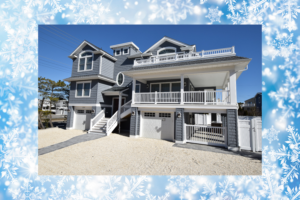With the temperatures dipping colder as winter approaches, we thought we’d share some of the best practices every homeowner should adopt for their custom home on LBI this winter if leaving it unoccupied. As an LBI builder for over thirty years, our team at Stonehenge Building & Development we have found these three tips helpful to winterize your custom home on LBI, so you can continue to enjoy it for generations to come!
#1: Like people, homes are not meant to be cold!
Homes need to be kept warm to a certain degree for many reasons. While it’s common for people to turn off their heat before they leave for the season, it’s actually recommended that vacation homeowners leaving for the winter should turn their thermostat to 55° Fahrenheit at the minimum. By doing so, you’ll keep your custom home on LBI warm enough to keep the pipes from freezing should the temperature drop to below freezing for a length of time. Just like us, homes are not meant to freeze, so keeping your heat on a low setting is critical to avoid costly damage.
#2: Standing water can do immense damage when frozen.
Another part of our recommended winterizing process is to drain all the waterlines (garden hoses, air conditioning lines, etc.) to prevent ruptures should your home experience a blizzard-induced power outage or other power failure. If the heat does go off for whatever reason, this can cause any remaining water in your home’s pipes to freeze and potentially cause those pipes to burst. Every custom home on LBI that we build has drains installed on the lower level—depending on the house design—which allows for drainage of both hot and cold water, which will help avoid a rupture if this scenario presents itself this winter.
#3: Sheetrock doesn’t like moisture.
Not only does sheetrock dislike extreme cold, finishes like paint and hardwood flooring are not meant to be exposed to the cold. Your house has naturally occurring moisture in it from day-to-day things you do, like taking showers or washing dishes, which becomes a part of your home’s routine atmosphere. If this moisture freezes during the winter, it can cause damage like buckling or warping of floors and walls. By keeping your heat set to a minimum of 55° Fahrenheit, there isless of a chance that this type of damage will occur during the winter months.
If you have any questions about how to winterize your home for the season, or you are considering building a new custom home on Long Beach Island, contact Stonehenge Building & Development today or visit StonehengeBuilt.com to learn why we’re the builder of choice on LBI.


